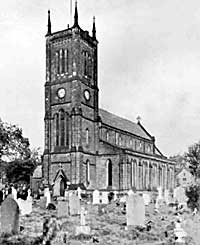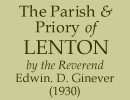< Contents | Manorial history >
1.—THE PARISH OF LENTON.
 |
Lenton parish church. |
THE Parish of Lenton is situated in the southern division of the hundred of Broxtowe, on the banks of the River Leen, near its confluence with the River Trent. It is bounded on the north by the parish of Radford, on the east by the parish of Standard Hill (S. James'), on the south by the River Trent, and on the west by the parishes of Beeston and Wollaton.
The name of the parish is undoubtedly derived from the River Len or Leen. Most place names derive themselves from some natural peculiarity, and the name Lenton is but a modern corruption of two old words, one of Celtic, and the other of Saxon origin. Linn (hlynna) = a pool or mere or rivulet, and Tun = a town, village or hill, by the side of the Linn or Lin or Line, hence Linntun.
The Leen rises near Robin Hood Hills, Newstead. "here runnith it (the River Leen) by Linten or Lenton, much frequented and famous in old time for the Abbay there of the Holy Trinity, founded by William Peverel, the base son of William the Conqueror, but now all the fame is only for a Faire there kept" (Camden's Britain).
The course of the Leen was altered by Peverel c1090. Beyond Lenton the original course of the river ran through the meadows in a direction bearing southwards to its confluence with the Trent, until in due time an artificial channel was made for it to turn eastwards, in order to bring a supply of water to the Town and Castle of Nottingham. In the loop formed by this deviation, and in view of the Castle, the Priory was built.
A relic of an earlier age than that of the Saxon has been found, in the form of a perforated stone axe, dug up in the sandhills of Wollaton Park.
The Angles came up the Trent and doubtless made a settlement at Linntun, cultivating parts of the parish. The Venerable Bede informs us that Paulinus, the first Archbishop of York, baptised his converts in the River Trent, near to the city which is called in the English language Tiovulfingacester, traditionally claimed as Southwell, so that he possibly visited this Anglo-Saxon village of Linntun. At the time of the Conquest, Unlof the Saxon had the manor of "Lentune," which was then given into the wardship of William Peverel, who allowed Unlof (otherwise Ulnod) to continue as tenant. In the Domesday Book is the following entry—" In Lentune, 4 Sochmen and 4 Bordars have two ploughs and a mill, Ulnod has one plough and one mill."
There were thus two mills early in Lenton. One was on the Leen, with ten acres of meadow and ten acres of underwood, but the value was only ten shillings. At least one mill was established after the Priory was founded, contiguous to the site thereof. The former of these mills is now hidden by the Mill Cafe and Garage near the Wollaton Park Gates on Derby Road, while the latter is behind Mitchell's Garage, off Radford Marsh, this being the Prior's Mill where all the corn of the Parish and Priory was ground. Some tooled stones in the doorway suggest reconstruction from the old Priory.
The old inhabitants of Lenton had a tradition that a fierce battle was fought between the Britons and the Romans, in the valley to the south-west of Old Lenton. A few odd Roman remains have been discovered at various times in Lenton, notably a small coin of Constantine the Second, A.D. 340, and one of the reign of Tacitus, 275-276 A.D.
The Parish, formerly included within the boundaries of the once famous forest of Sherwood, likewise comprised in earlier days the now extinct villages of Morton, Keighton and Sutton Passeys. There are now no traces of these three lost villages of Lenton, or of their churches, if any. There was, according to the Domesday Book, a manor named " Mor-tune," where Bovi the Saxon had land, which was given to William Peverel, and by him presented to Lenton Priory.
Morton is supposed to have been in the locality of Dunkirk Farm. If the name Dunkirk is modern, it may be an allusion to Dunkerque in France, otherwise it means, "the Church of the dunes" or sandhills.
Keighton, or Kirton, or Kirkton, is said to have occupied the site between Spring Close and Highfield Park, on the south side of "Cut-through Lane" opposite Lenton Hurst, once the residence of Francis Wright, later of Frederick Wright, J.P., now enlarged by Lord Trent for the use of the University College as a Hostel. At Kirton in 1387 the houses belonging to the Prior were stated to have been "as much in want of repair as of tenants." The meadows on the hillside which slopes towards the Tuttlebrook or Tottlebrook used to be known as the "Keightons" (pronounced Keetons).
Sutton Passeys was situated somewhere in Wollaton Park. Originally called Sutton, it was in the possession of the Passey family in Queen Elizabeth's reign, hence Sutton Passeys (Sutton of the Passeys). Sutton probably existed from Saxon days. There was a church there in 1340, dedicated to S. Mary. This chantry was removed to Wollaton in 1360. The name of the village is preserved in Sutton Passeys Crescent, the new drive laid round the block of council houses built on the Estate.
The names of many roads and districts of the Parish have a similar interest. The locality of the Priory is perpetuated in the names of the streets, Abbey Street, Priory Street, Cloister Street, Friar Street, Choral Yard, etc. Derbigate (Derby Road), so named in 1301, is now the most interesting road out of Nottingham. Gregory Street perpetuates the name of the family who have been for centuries the Lords of the Manor; Willoughby Street indicates the connection of the Willoughbys with Lenton. Lenton Sands tells of a time when loose sand formed ruts and blew away; Cut-through Lane tells of a footpath cut through the sand-hills and forming a shorter way to Beeston, the name at one time becoming perverted to "Cutthroat" Lane. Spring Close tells of the presence of running water in a remarkable geological formation of contorted inter-glacial alluvium of the Trent.
Bestwood—anciently Beskwood, Boskwood, Boscwood or Buscwud—Park was formerly an outlying portion of the Parish of Lenton, in which royal forest the monks of Lenton had the royal permission to gather wood, under Henry I and Henry III. In 1874, Bestwood Park was constituted a separate ecclesiastical district, under the provisions of the Act of Parliament authorising the formation of new benefices, and in 1878 was constituted a separate and independent parish for all purposes. The first Vicar was the Rev. W. R. Cripps, a Curate of Lenton, now buried at Mentone, S. France.
The parish of Lenton now comprises Old and New Lenton, Dunkirk and Lenton Sands, parts of the Wollaton Park and Lenton Abbey Housing Estates, including the new University College, Highfields, built by Lord Trent, and Grove Farm, belonging to H.R.H. the Prince of Wales.
The Headquarters of the Territorial Forces of the County and City are on the borders of the Parish, in a building on the Derby Road erected in 1912. The present Vicar of Lenton, the Rev. R. J. R. Skipper, is Chaplain to the Robin Hoods.
It is interesting to note that in olden times parochial perambulations, for the purpose of "beating the bounds," i.e., marking out the boundaries of the Parish, and for the purposes of assessment and levy, were important institutions, and carried out at Lenton. Probably the most notable perambulation in the Parish was the one made May 1st, 1856, of the detached portion of the parish known as Bestwood Park. An interesting account of this may be read in John T. Godfrey's History of the Parish and Priory of Lenton.
A number of other interesting items may conveniently be referred to at this stage.
A House of Carmelite Friars at Lenton is mentioned on the Patent Roll of Edward I, second year.
It is supposed that the two varieties of Purple Crows, or Meadow Saffron, found in Nottingham Meadows, were imported by the monks of Lenton.
Count Tallard, who was taken prisoner in 1704 at the Battle of Blenheim, first cultivated celery on the banks of the Leen where it grew wild.
"On the 7th July, 1558, within a mile of Nottingham, was a marvellous tempest of thunder, which, as it came through two towns (no doubt Wilford and Lenton) brought down all the houses and churches. The bells were cast to the outside of the churchyards, and some webs of lead 400 feet into the field, writhen like leather. The River Trent running between the two towns, the water of which, with the mud in the bottom was carried a quarter of a mile and cast against trees with the violence whereof the trees were torn up by the roots and cast twelve score yards off, also a child was taken forth of a man's hand and carried two spears length high, and then let fall 200 feet off, of which fall it died. Five or six men thereabouts were slain by the storm, during which hailstones fell measuring fifteen inches in diameter." Such is the early record of this remarkable storm.
Lenton played a most important part in the development of the Lace Making Industry, and sixty years ago was known as "The Golden Valley," there being some twenty firms manufacturing lace curtains, fancy laces, spotted and plain nets; Messrs. B. Walker & Co., of Spring Close being at that time one of the largest manufacturers of curtains in the world. Five firms were making every class of lace machines, curtains, mechlin, plain and spotted nets, and Levers laces. The only lace machine exhibited at work, in any large exhibition, was in 1851 at the Crystal Palace. It was made by the firm of T. Keeton, of Lenton. To-day the whole of the lace trade and machine building has left Lenton, with the exception of a small plant of modern curtain machines at Spring Close.
There were at one time two foundries, one in Willoughby Street and one in Tyne Street.
The War Memorial at the junction of Sherwin Road and Church Street was erected by public subscription, the land being given by Sir Albert Ball, to record the services of close upon 400 men of Lenton who gave their lives for King and country in the Great War, 1914-1918. The Memorial Homes at the junction of Church Street and Sherwin Road were erected and endowed by Alderman Sir Albert and Lady Ball, in memory of their son, Captain Albert Ball, V.C., the tenants all being parents or wives of men who fell in the War. The endowment includes Birch House (the residence of Miss H. Tucker), Jessamine Cottage where Sir Joseph Renals, a Lord Mayor of London was born, Chain row, Knight's Yard, etc.
Until 1877, Lenton was part of the County of Nottingham, and all its history appears in such relation, but in that year an Act of Parliament was passed whereby it became part of the town, now the City of Nottingham.
The population of the Parish in 1921 was 13,928. It must be nearly twice that now, as since that time both the Wollaton Park and Lenton Abbey Housing Estates have come into existence, and much new building in other parts of the parish, notably on Lenton Sands.
For ecclesiastical purposes, the Parish is included in the diocese of Southwell, and in the archdeaconry and rural deanery of Nottingham.
< Contents | Manorial history >
